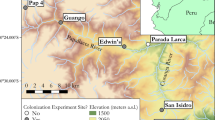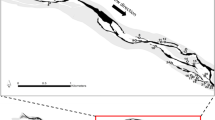Abstract
The trends in colonization and establishment of equilibrium benthic communities in a reclaimed coal strip-mined river channel were analyzed for 17 months after channel construction. The MacArthur-Wilson island colonization theories and an analysis of community composition by simultaneous daily comparisons between source and new channel communities were employed. Each downstream site attained an equilibrium condition at approximately twice the time required for a site 200 m closer to the upstream source area of drifting colonizers. When considering functional groups of aquatic invertebrates, the collector-gatherers and collector-filterers of detrital material were the initial colonizers. With respect to foraging habit, those invertebrates which were found commonly in the water column above the substrate, the swimmers and clingers, were found to be the initial colonizers of the most distant substrate islands. As habitat complexity increased, trophic complexity increased with priority of arrival and dispersal potential determined by trophic position and foraging habit. It is suggested that the Jaccard community association analysis be used to assess stable new community conditions. The index provides an indication in changes in diversity and density and can be compared with source area communities to determine simultaneous changes within both communities. Ultimately, the restored channel ‘islands’ become a continuous extension of the source area habitat. Colonization trends and time to stability are affected by number of pools, tributary streams, and elimination of rare species populations prior to reclamation.
Similar content being viewed by others
References
Bishop, J. E. & Hynes, H. B. N., 1969. Upstream movements of the benthic invertebrates in the Speed River, Ontario. J. Fish. Res. Bd Can. 26: 279–298.
Cairns, J. Jr., Crossman, J. S., Dickson, K. L. & Herricks, E. E., 1971. The recovery of damaged streams. ASB Bull. 18: 79–106.
Cherry, D. S., Larrick, S. R., Guthrie, R. K., Davis, E. M. & Sherberger, F. F., 1979. Recovery of invertebrate and vertebrate populations in a coal ash stressed drainage system. J. Fish. Res. Bd Can. 36: 1089–1096.
Church, J. O., 1976. Cluster analysis in biological studies. Inst. of Paper Chemistry, Appleton, Wisc., Proj. Rpt. No. 3273.
Cowell, B. C. & Carew, W. C., 1976. Seasonal and diel periodicity in the drift of aquatic insects in a subtropical Florida stream. Freshwat. Biol. 6: 587–594.
Cummins, K. W. & Klug, M. J., 1979. Feeding ecology of stream invertebrates. Ann. Rev. Ecol. Syst. 10: 147–172.
De La Cruz, A. A. & Post, H. A., 1977. Production and transport of organic matter in a woodland stream. Arch. Hydrobiol. 80: 227–238.
Dickson, K. L. & Cairns, J. Jr., 1972. The relationship of freshwater macroinvertebrate communities collected by floating artificial substrates to the MacArthur-Wilson equilibrium model. Am. Midl. Nat. 88: 68–75.
Elliott, J. M., 1971. Upstream movements of benthic invertebrates in a Lake District stream. J. Anim. Ecol. 40: 235–252.
Fuller, R. L. & Stewart, K. W., 1979. Stonefly (Plecoptera) food habits and prey preference in the Dolores River, Colorado. Am. Midl. Nat. 101: 170–181.
Gore, J. A., 1978. A technique for predicting in-stream flow requirements of benthic macroinvertebrates. Freshwat. Biol. 8: 141–151.
Gore, J. A., 1979. Patterns of initial benthic recolonization of a reclaimed coal strip-mined river channel. Can. J. Zool. 57: 2429–2439.
Hynes, H. B. N., 1970. The Ecology of Running Waters. Univ. Toronto Press, Toronto, Ontario.
Khalaf, G. & Tachet, H., 1977. Les dynamiques de colonisation des substrats artificiels par les macroinvertebrates d'un cours d'eau. Annls Limnol. 31: 169–190.
MacArthur, R. H. & Wilson, E. O., 1967. The Theory of Island Biogeography. Princeton Univ. Press, Princeton, New Jersey.
McLay, C., 1970. A theory concerning the distance traveled by animals entering the drift of a stream. J. Fish. Res. Bd Can. 27: 359–370.
Meier, P. G., Penrose, D. L. & Polak, L., 1979. The rate of colonization by macro-invertebrates on artificial substrate samplers. Freshwat. Biol. 9: 381–392.
Merritt, R. W. & Cummins, K. W., 1978. An introduction to the Aquatic Insects of North America. Kendall/Hunt, Dubuque, Iowa.
Nichols, F. H., 1980. Long-term stabilizing influence of ‘rare’ species on benthic community structure in Puget Sound, Washington. 43rd Annual Meeting, Am. Soc. Limnol. Oceanogr. Knoxville, Tenn.
Nie, N. H., Hull, C. H., Jenkins, J. G., Steinbrenner, K. & Bent, D. H., 1975. SPSS-Statistical Package for the Social Sciences. McGraw-Hill, New York.
Patrick, R., 1959. Aquatic life in a new stream. Water and Sewage Works. 106: 531–535.
Patrick, R., 1975. Stream Communities. In: Cody, M. L. & Diamond, J. M. (Eds.) Ecology and Evolution of Communities. Belknap Press, Harvard Univ., Cambridge, Mass.
Peckarsky, B. L., 1980. Influence of detritus upon colonization of stream invertebrates. Can. J. Zool. 37: 957–963.
Sheldon, A. L., 1969. Size relationships of Acroneuria californica (Perlidae; Plecoptera) and its prey. Hydrobiologia 34: 85–94.
Sheldon, A. L., 1972. Comparative ecology of Arcynopteryx and Duira in a California stream. Arch. Hydrobiol. 69: 521–546.
Sheldon, A. L., 1977. Colonization curves: application to stream insects on seminatural substrates. Oikos 28: 256–261.
Sheldon, A. L., 1980. Resource division by perlid stoneflies (Plecoptera) in a lake outlet ecosystem. Hydrobiologia 71: 155–161.
Siegfried, C. A. & Knight, A. W., 1976. Prey selection by a setipalpian stonefly nymph, Acroneuria (Calineuria) californica Banks (Plecoptera: Perlidae). Ecology 57: 603–608.
Silvert, W., 1979. Practical curve fitting. Limnol. Oceanogr. 24: 767–773.
Simberloff, D., 1978. Using island biogeographic distributions to determine if colonization is stochastic. Am. Nat. 112: 713–726.
Stauffer, J. R., Beiles, H. A., Cox, J. W., Dickson, K. L. & Simonet, D. E., 1974–76. Colonization of macrobenthic communities on artificial substrates. Rev. Biol. 10: 49–61.
Stoneburner, D. L. & Smock, L. A., 1979. Seasonal fluctuations of macroinvertebrate drift in a South Carolina piedmont stream. Hydrobiologia 63: 49–56.
Townsend, C. R. & Hildrew, A. G., 1976. Field experiments on the drifting, colonization, and continuous redistribution of stream benthos. J. Anim. Ecol. 45: 759–772.
Ulfstrand, S., 1968a. Life cycles of benthic insects in Lapland streams (Ephemeroptera, Plecoptera, Trichoptera, Diptera Simuliidae). Oikos 19: 167–190.
Ulfstrand, S., 1968b. Benthic animal communities in Lapland streams. A field study with particular reference to Ephemeroptera, Plecoptera, Trichoptera, and Diptera Simuliidae. Oikos, Suppl. 10: 1–120.
Vinikour, W. S., 1980. Biological consequences of stream routing through a final-cut strip mine pit: benthic macroinvertebrates. Hydrobiologia 75: 33–43.
Wallace, J. B. & Merritt, R. W., 1980. Filter-feeding ecology of aquatic insects. Ann. Rev. Entomol. 25: 103–132.
Walton, O. E. Jr., 1980. Invertebrate drift from predator-prey associations. Ecology 61: 1486–1497.
Walton, O. E. Jr., Reice, S. R. & Andrews, R. W., 1977. The effects of density, sediment particle size and velocity on drift of Acroneuria abnormis (Plecoptera). Oikos 28: 291–298.
Waters, T. F., 1972. The drift of stream insects. Ann. Rev. Entomol. 17: 253–272.
Waters, T. F. & Knapp, R. J., 1961. An improved bottom fauna sampler. Trans. Am. Fish. Soc. 90: 225–238.
Wilhm, J., 1972. Graphic and mathematical analyses of biotic communities in polluted streams. Ann. Rev. Entomol. 7: 223–252.
Williams, D. D. & Hynes, H. B. N., 1977. Benthic community development in a new stream. Can. J. Zool. 55: 1071–1076.
Wise, D. H. & Molles, M. C. Jr., 1979. Colonization of artificial substrates by stream insects: influence of substrate size and diversity. Hydrobiologia 65: 69–74.
Author information
Authors and Affiliations
Rights and permissions
About this article
Cite this article
Gore, J.A. Benthic invertebrate colonization: source distance effects on community composition. Hydrobiologia 94, 183–193 (1982). https://doi.org/10.1007/BF00010899
Received:
Accepted:
Issue Date:
DOI: https://doi.org/10.1007/BF00010899




